Molecular Gastronomy / Cooking: BEST OF THE WEB sphericals, caviar & raviole recipes
Are you looking for a surprise element for your next dessert? Sphericals have a liquid centre encapsulated by a gel membrane. This is achieved by using sodium alginate which gels in the presence of calcium.
molecular gastronomy kits available here
There are lots of videos and photos on the web showing how to make sphericals or raviole and caviar, but some are just repeating the same recipe as other websites, have no recipe details or they are in another language.
Here is a collation of the best sweet spherical, caviar and raviole recipes. For more information on each one click on the picture to go to the source.
Scroll down for ten tips for making sphericals at home.
| Bath Ingredients | Caviar / Spherical Ingredients | Preparation Summarized | |
custard spherical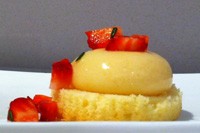 |
1L (0.26 gallons) water 5g (0.18 ounces) sodium alginate |
1 cup of heavy cream 1/6 cup sugar 4 egg yolks ¼ tsp vanilla extract 5 g (0.18 ounces) Calcium Lactate pinch of Xanthan |
Bring the cream & vanilla to boil. Whisk the egg yolks with the sugar in a bowl on simmering water until the mixture thickens. Remove from heat and add the heated cream. Cool, add xanthum if needed. Dilute the calcium lactate in a tabespoon of water and add to the custard. |
chocolate spherical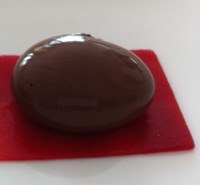 |
500ml water | 250ml water small pinch sodium bicarb 1.8 g (0.06 ounces) Sodium Alginate 250 g (8.82 ounces) dark chocolate |
Blend water and sodium citrate in a large bowl. Add the sodium alginate and blend again. Put in a saucepan and heat without boiling. Break the chocolate into a bowl and pour the sodium alginate mixture over the chocolate. Allow to sit and then whisk together the chocolate and liquid.Place spoonfuls into the calcium bath and allow to sit for 10 minutes. Remove and rinse in water bath. |
Divine Chocolate Ginger Sphericals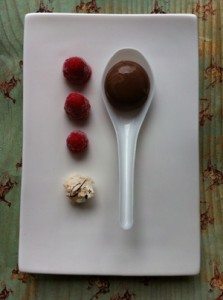 |
1L (0.26 gallons) water 5g (0.18 ounces) sodium alginate |
200ml cream 1 tablespoon grated fresh ginger (optional) 20g (0.71 ounces) (1 tablespoon) caster sugar 3.2g (0.11 ounces) (1 teaspoon) Calcium Chloride 100g (3.53 ounces) dark chocolate melts (or chopped dark chocolate) |
Combine the cream, ginger, sugar and calcium chloride and microwave for 1min 30sec (or bring to the boil on the stovetop). Strain through a sieve to remove ginger and then pour hot cream mixture over the dark chocolate. |
mango caviar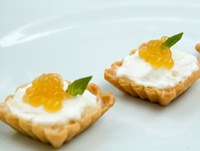 |
3g (0.11 ounces) calcium chloride 500ml water |
250ml mango nectar 2g (0.07 ounces) sodium alginate 0.2g (0.01 ounces) sodium citrate heat to 90 deg C then cool |
Pour a third of the mango nectar into blender with the alginate, blend well. Heat to 90 º C and remove from heat. Add remaining juice and dissolve the sodium citrate. Strain. |
melon caviar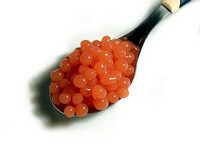 |
1000ml water6.5g (0.23 ounces) calcium lactate | 500 g (17.64 ounces) Cantaloupe to make 250ml juice2g (0.07 ounces) sodium alginate | Puree the flesh of the melon in a blender. Strain through muslin cloth. Take 100ml Cantaloupe juice and mix with sodium alginate in blender. Mix with 150ml remaining parts, strain and let rest for 30 min before using. |
blueberry caviar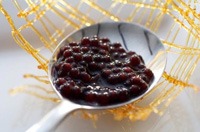 |
6.5g (0.23 ounces) Calcium Chloride1lt of water | 400g (14.11 ounces) blueberries1 cup of white sugar ½ cup good dry white wine 1g (0.04 ounces) Sodium Alginate ¼ tsp sodium nitrate |
Place blueberries, white sugar and white wine, over a very low heat for an hour Puree, and drain through muslin cloth over night. Freeze, place ice block on a muslin cloth again and let “defrost” in the fridge. Take this juice and add in the sodium nitrate, mix it in with a stick blender, add the sodium alginate and blend, leave for 1 hour. |
chocolate cherry spherical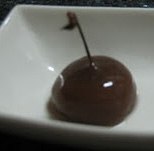 |
400ml water 100ml Maker’s Mark Bourbon 30g (1.06 ounces) cocoa 2.5g (0.09 ounces) sodium alginate |
120g (4.23 ounces) strained pureed cherry 0.2g (0.01 ounces) Ascorbic acid 0.5g (0.02 ounces) sodium citrate 1.8g (0.06 ounces) gluconolactate 0.5g (0.02 ounces) xanthan |
Puree cherries and strain through muslin cloth to get 120g (4.23 ounces). On a blender add other ingredients one at a time. Leave to stand for an hour to let any air bubbles escape. |
watermelon caviar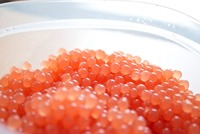 |
500g (17.64 ounces) Water 2.5g (0.09 ounces) Calcium chloride |
250g (8.82 ounces) concentated watermelon juice 2g (0.07 ounces) Sodium alginate source |
Boil the water melon juice to lose some of the water. Take 250g (8.82 ounces) of this concentrated juice and blend with sodium alginate. |
strawberry yoghurt spherical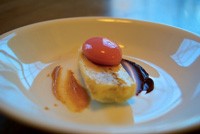 |
500ml water 1.5g (0.05 ounces) sodium alginate |
plain yoghurt strawberry ‘nesquick’ powder | mix some nesquick with the yoghurt to desired taste. |
lemon iced tea spherical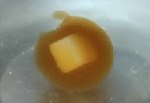 |
alginate bath (no quantities given for this recipe) | tea calcium salts frozen lemon juice |
Mix tea calcium salts. with Place a cube of frozen lemon juice in a tablespoon of the tea. Pour into bath. |
coconut cream spherical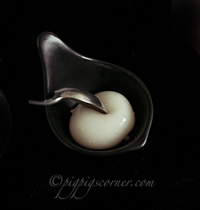 |
4 g (0.14 ounces) sodium alginate | 10 ml of coconut cream | Mix coconut cream, water and sugar with calcium lactate. Using a spoon, make pearls. Store in the freezer before cooking in chocolate lava cakes. |
mint caviar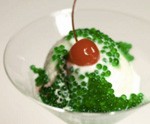 |
5g (0.18 ounces) calcium lactate 4 cups of water |
1 1⁄4 cups of water 4g (0.14 ounces) sodium alginate 1/3 cup mint syrup |
Blend water and alginate to dissolve, then put in a pan and bring to the boil then set aside for 10 minutes. Mix 1/3 cup alginate syrup with mint syrup. |
mint yoghurt spherical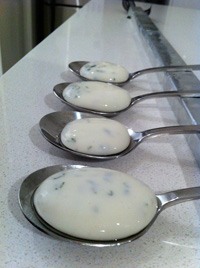 |
2g (0.07 ounces) sodium alginate 500ml water |
high calcium plain yoghurt chopped mint |
Mix mint into the yoghurt and spoon into the alginate bath. |
lychee caviar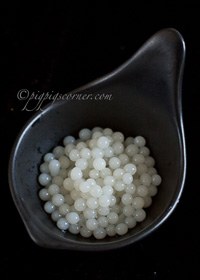 |
2.5 g (0.09 ounces) calcium chloride 500 g (17.64 ounces) water |
Use canned lychees to get: 210 g (7.41 ounces) lychee 40 g (1.41 ounces) lychee liquid 2 g (0.07 ounces) sodium alginate |
Blend the lychee until smooth and pass this through a sieve. Add Algin to 1/3 of the lychee mixture and blend until completely dissolved. Mix Algin-lychee mixture to the rest of the lychee mixture and leave to rest for about 1 hr so that it loses part of the air created by blending. |
pomegranate caviar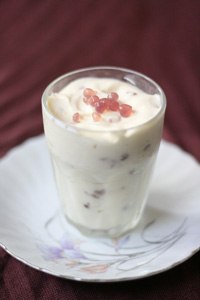 |
3.25g (0.11 ounces) calcium chloride 500g (17.64 ounces) water |
125g (4.41 ounces) pomegranate and cherry juice (POM brand) 1g (0.04 ounces) sodium alginate 1/2 tsp sodium bicarbonate |
Blend the juice and sodium alginate using a stick blender. Add the sodium bicarbonate and blend again. This will change the consistency to a thin gel. Leave to stand for half an hour so the air bubbles rise to the surface. |
fruit gel ‘fake’ caviar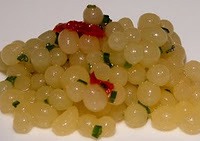 |
cold oil | Fruit or juice that you want to make spheres from and weigh the liquid amount out. Agar 2.5% of the weight of the juice. |
Heat the juice to 60 degrees and add agar. Blitz with an immersion blender to make sure that it is well dispersed. Drop into cold oil. |
grapefruit caviar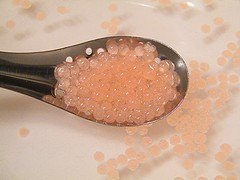 |
540ml Cold Water 3 g (0.11 ounces) Calcium Chloride |
270ml Ruby Red Grapefruit Juice 1g (0.04 ounces) Sodium Alginate |
Mix the sodium alginate with 1/2 the fruit juice and blend until completely dissolved.Mix in the remaining fruit juice |
raspberry ravioles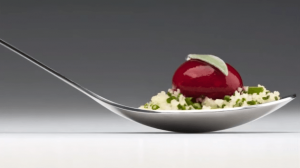 |
500ml water2 g (0.07 ounces) Sodium Algninate | 1 2/3 cup raspberries 1 Tablespoon sugar 1/2 teaspoon calcium lactate |
Blend the raspberries, calcium lactate and sugar in a blender. |
Ten tips for making sphericals at home:
1. If using a sodium alginate bath make it a day ahead. To mix the sodium alginate with the water first combine it with some sugar, this helps it not to clump together. Sprinkle a little on top of the water, mix and repeat until it is all added then blend for at least 2 minutes. You will need to use a blender. Leave in the fridge overnight so all the air bubbles disappear and the sodium alginate can completely rehydrated. If you do not do this you will get air bubbles in your gel coating so it will not look smooth and shiny.
2. Test, test, test… if you are trying a new recipe pour some of your alginate or calcium bath into a small bowl and use it to test your spherical solution. If your solution does not become properly encapsulated in alginate gel it will disperse in the bath – making a mess. This methods saves you wasting the whole bath.
3. What if your sphericals are mishapen? If they flatten out before sinking you may need to make your mix thicker / heavier – play with the viscosity of the solution using xanthum gum to thicken it (remember a little goes a long way blend and leave for a couple of minutes). It could also be too high in fat or have too many little air bubbles both of which cause it to float. If you caviar is tadpole shaped check that it is not too thick and experiment with adjusting the height and angle of pipette. If your caviar is flat either thicken or drop from slightly higher so it penetrates the surface as it drops in.
4. If using an alginate bath (reverse spherification) do no allow your sphericals to touch while in the bath or they will gel together.
5. Use distilled water in the alginate bath – or the calcium in your tap water may cause it to gel.
6. The alginate gel is senstive to pH, it works best with pH 4.5 to 6. Click here for pH levels of foods. You can adjust the pH content by adding sodium citrate to the liquid base.
7. Alcohol breaks down the gel so if using in cocktails it will only work with drinks that are less than 20% alcohol.
8. Sodium alginate cannot be dissolved in oil.
9. If it is not forming a gel and when you stir it the mixture just disperses in the bath or it forms a weak gel that breaks as soon as you lift it out of the bath – check the amount of additives, check the pH of the solution, look at the fat and alcohol content of ingredients in your recipe.
10. To get perfect spheres freeze the sauce in a spherical mould and then place in a warm bath to encapsulate.
My Cookbook
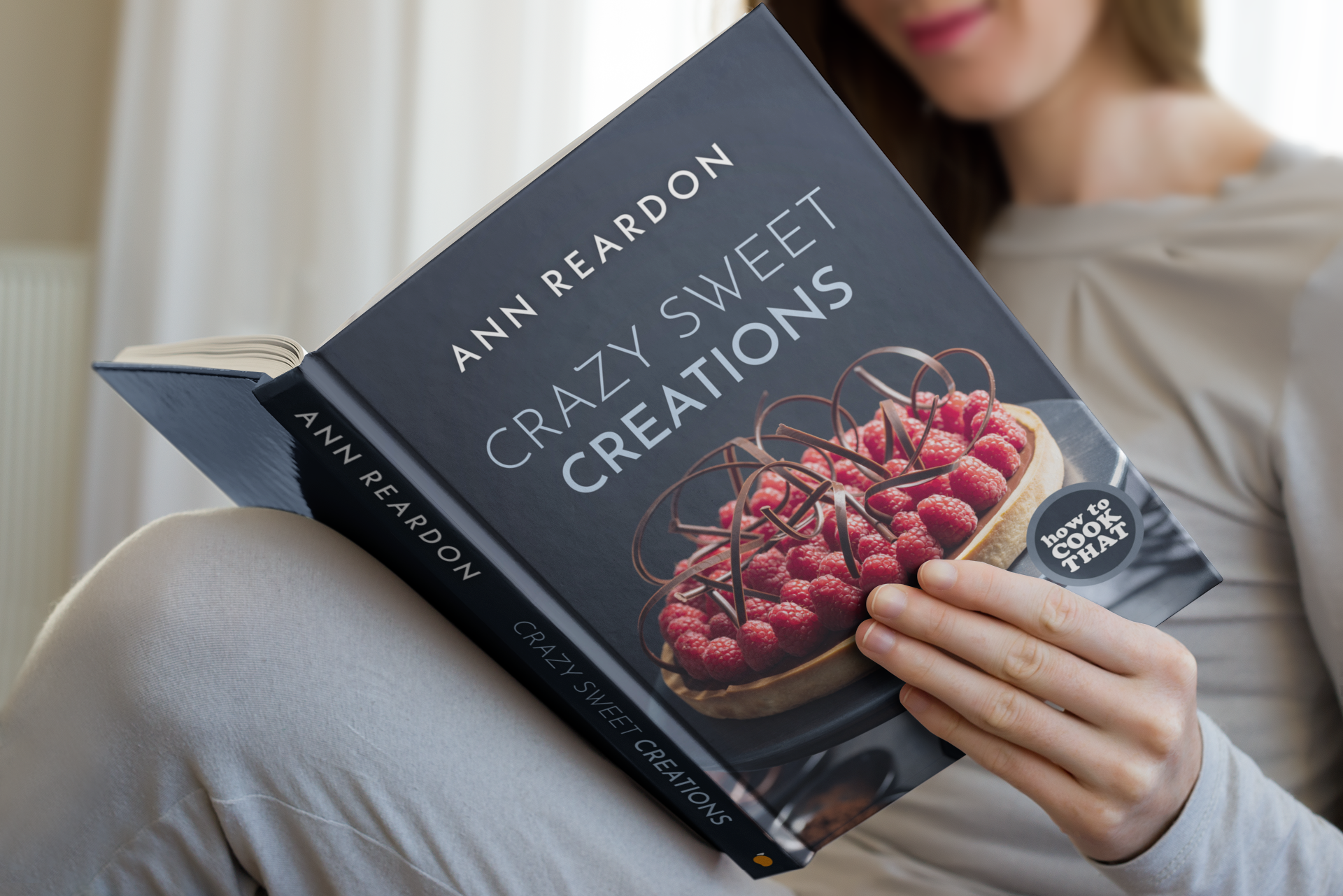 Stores that sell my book listed by country:
http://bit.ly/ARcookbook
All recipe quantities in the book are in grams, ounces and cups.
Stores that sell my book listed by country:
http://bit.ly/ARcookbook
All recipe quantities in the book are in grams, ounces and cups.



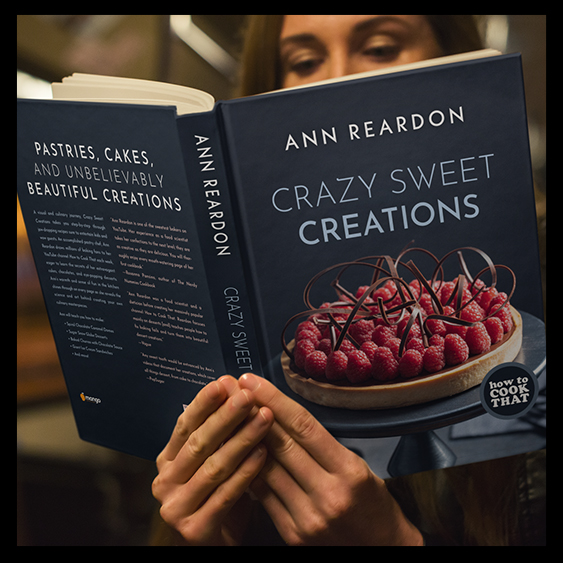

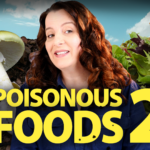



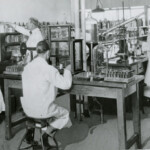
 we respect your email privacy
we respect your email privacy
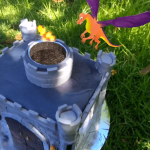
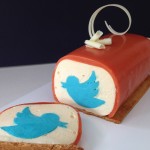
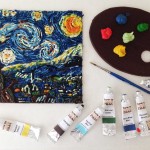
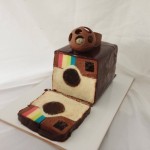
3ingress
I need help with dehydrating a compound butter I made with fresh fruits.
Peach
Cherry
Strawberry
I am attempting to use these for the beurrage in croissants and other laminated baked goods. I want to use the least amount of having to add flour/icing sugar as compensation to the increase of liquid from the juice of the fruit. Peaches are my biggest nemesis currently.
I am using (uber expensive) 86% butterfat butter trying to help balance this increase of liquid. Any thoughts?
If nothing else I have some amazing fruit compound butters for, well just about everything.
Thanks
Hi Mallissa, Have you tried using freeze dried strawberries?. Perhaps you could put them in a blender and turn them into a powder – that way you are not adding any liquid. As for decreasing the liquid in the butter that you already have the only way I can think of is heating it to melt the butter and keep heating over low heat to let the liquid evaporate, but that will change the flavour of the butter.
hi dear ann… finally i can find calcium lactat… but i dont have sodium alginat… can i make some dessert whit that?
Thanks for finally writing about > HowToCookThat : Cakes,
Dessert & Chocolate | Molecular Gastronomy / Cooking:
BEST OF THE WEB sphericals, caviar & raviole recipes – HowToCookThat
: Cakes, Dessert & Chocolate < Loved it!
I just purchased some of these chemicals used in Molecular Gastronomy & tried out some recipes. Unfortunately the recipe for plain Spherification using Calcium lactate bath for making Cocoa Caviar(which i got from another site that follows the exact same measurements as Mint Caviar) did not turn out as expected:( I Instead of getting perfectly round sphericals i’m chunks of cocoa across the bath. And when i tried making Drinkable Yogurt Ravioles using Sodium Alginate the same happened:((( I really don’t get what went wrong as i followed the entire recipe to the T including the measurements. If you could suggest any tips i would be very grateful, because i need to present these pretty soon.
Hi Shayoni, The higher fat content of some ingredients can impact the process significantly. This sounds like it has caused you problems with your cocoa caviar. With the yoghurt Ravioles, Ann recommends To get perfect spheres, freeze the sauce in a spherical mould and then place in a warm bath to encapsulate. You could check out the updated recipe here for Mango Lime sphericals : https://www.howtocookthat.net/public_html/vanilla-pancotta-dessert-recipe/
Im looking to make the coconut sphere, what does ‘cl’ stand for next to the coconut cream amount, thankyou!
sorry, also.. when there is water in the flavoured liquid can you just use normal tap or filtered water? rather than distilled? or does it affect the reaction still. thanks again!
Hi Kasey, It’s best to use distilled water for best results.
I am interested in making the chocolate sphericals however the recipe above is just a duplicate of the custard spherical. Could you provide the recipe for the chocolate ones? Thanks so much!
Great pick up Beth. I have updated the method. You will also find the title link for the chocolate spherical on this page, will take you to a more detailed explanation and the correct method. Have fun making these!
I am interested in making the chocolate sphericals but the directions seem to be directions for the custard sphericals. Can you provide the recipe for the chocolate ones? Thanks!
how far in advance can I make raspberry raviolis, I am planning an event so I could use as much pre-prep time as possible. thanks!
Hi bonnie, you can make them up to half a day ahead and leave in liquid, so they don’t dry out. Please not that if you do that some of the raspberry can leach out into the liquid and vice versa so I suggest a sweet simple syrup is best.
Hi, I’m trying to make raspberry caviar. I have everything I should need but it doesn’t seem to woke. The recipe I am using is 2g sodium alginate to 450 Ml water. Then 500ml of raspberry puree to 5g calcium lactate. Dropping them in with pipettes, but no gel seems. Doing reverse spherification. Can you help me?
Hi dan, I think your calcium is too low in the raspberries. 120ml of raspberry puree needs 1/2 teaspoon of calcium lactate.
Aslo caviar is usually done the other way putting the calcium in the bath and the alginate in your raspberry so the raspberry gels. The way you are trying to do it a membrane will form on the outside of the tiny caviars making them look chunky. If I was you I’d add more calcium salts and make sphericals with what you’ve got and then try the other way for caviar.
I purchased Jacquard Sodium Alginate, I wonder is it safe for cooking? Are all sodium alginates safe to eat?
Hi Genny, Good question – The Jacquard Sodium Alginate is a seaweed derivative that is used to thicken dyes for painting, stamping or screen printing. So it is the same substance, but as it is not intended for human consumption it would not be put through the rigorous testing that the edible ones are. As such it may contain other contaminants. It is a bit like comparing tinned tuna for cats to tinned tuna for people – they are both tuna but one has to pass a lot more stringent tests to make it onto the market. Personally I would not eat it. You can get a molecular gastronomy kit here http://www.amazon.com/gp/search/ref=as_li_qf_sp_sr_il_tl?ie=UTF8&camp=1789&creative=9325&index=aps&keywords=molecular%20gastronomy%20kit&linkCode=as2&tag=howtocookthat-20
i just got a kit- looking forward to play with it. my culinary instructors will have heart attack- ha ha!
Have fun Mia, if you come up with some fantastic new recipes share them here for us all to try.